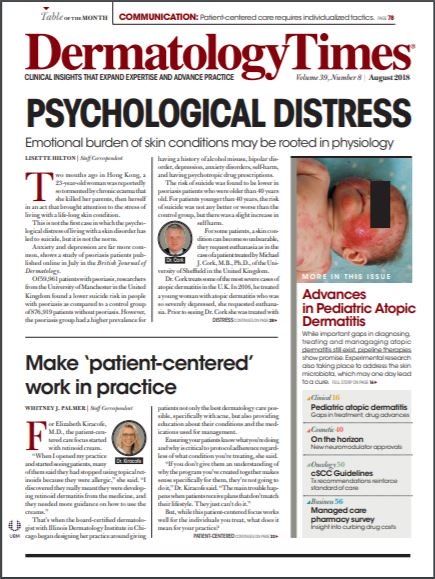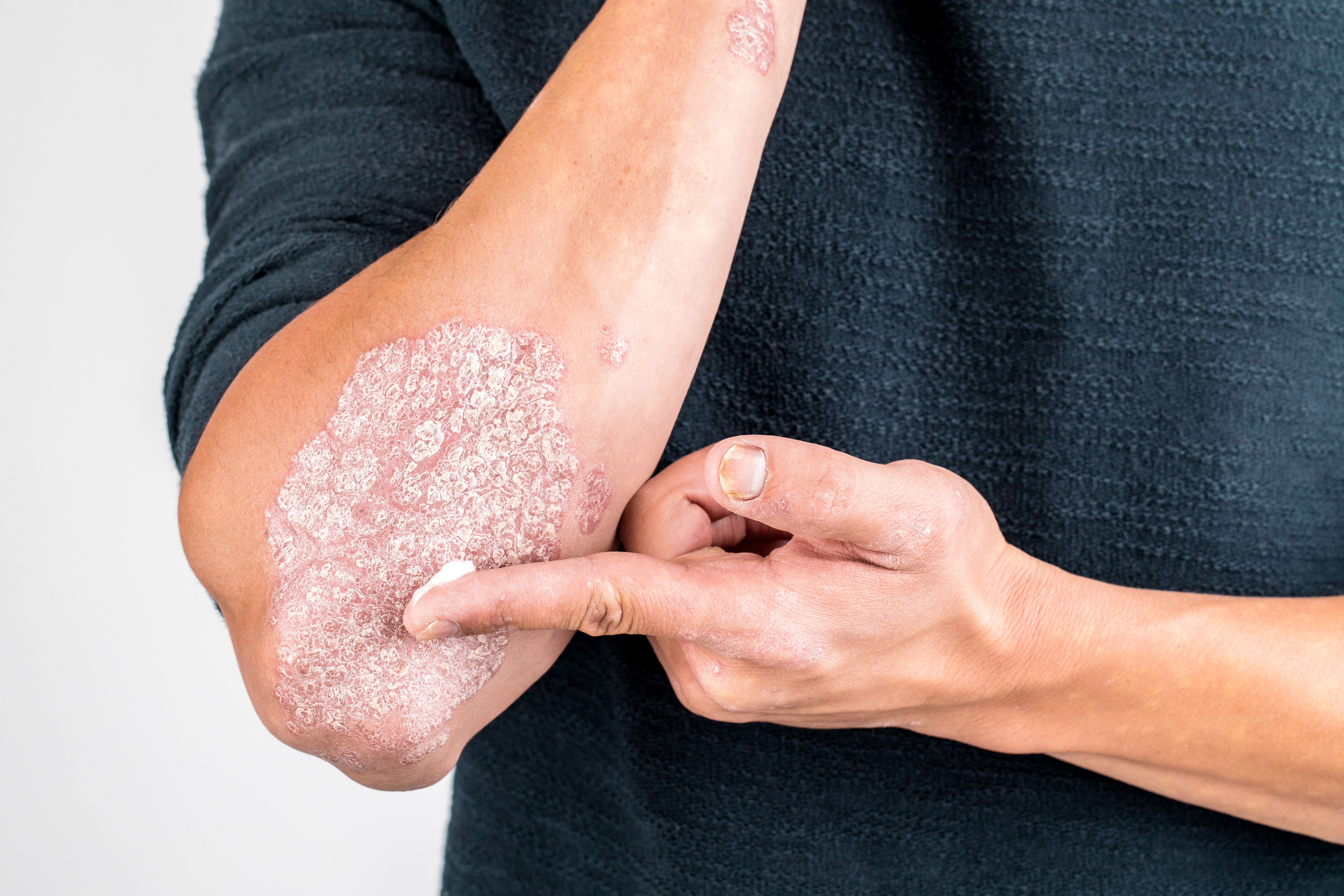- Acne
- Actinic Keratosis
- Aesthetics
- Alopecia
- Atopic Dermatitis
- Buy-and-Bill
- COVID-19
- Case-Based Roundtable
- Chronic Hand Eczema
- Chronic Spontaneous Urticaria
- Drug Watch
- Eczema
- General Dermatology
- Hidradenitis Suppurativa
- Melasma
- NP and PA
- Pediatric Dermatology
- Pigmentary Disorders
- Practice Management
- Precision Medicine and Biologics
- Prurigo Nodularis
- Psoriasis
- Psoriatic Arthritis
- Rare Disease
- Rosacea
- Skin Cancer
- Vitiligo
- Wound Care
Publication
Article
Dermatology Times
IL-23 guselkumab significantly improves symptoms in psoriatic arthritis
Author(s):
This is the first time an IL-23 blocking drug has been shown to improve signs and symptoms of psoriatic arthritis.

A new phase two study shows that guselkumab significantly improves signs and symptoms of psoriatic arthritis (PsA), supporting the importance of interleukin (IL)-23 as a therapeutic target in PSA.
Published in the June 2018 issue of The Lancet, the study shows that guselkumab significantly outperformed placebo in terms of American College of Rheumatology (ACR) 20 response at week 24, as well as several secondary outcomes related to bones, joints and quality of life out to nearly a year.
"This is the first published study of an IL-23-blocking drug, which offers a novel mechanism of action, in psoriatic arthritis," said lead investigator Atul Deodhar, M.D., of the Oregon Health & Science University in Portland, Ore. Guselkumab seems to improve all manifestations of psoriatic disease, including skin, joint and enthesial involvement, along with dactylitis, he added. "The other exciting part is the significant improvement in patients' functioning, which is not surprising because patients' pain, swelling and skin improved."
Investigators randomized 100 patients to subcutaneous guselkumab 100 mg and 49 to placebo at weeks zero, four, and every eight weeks thereafter for 24 weeks. Investigators switched patients who experienced less than 5 percent improvement in swollen and tender joint counts at week 16 to ustekinumab. This group included 10 percent of guselkumab-treated patients and 35 percent of placebo-treated patients. At week 24, the remaining placebo-treated patients (59 percent) crossed over to guselkumab 100 mg at weeks 24, 28, 36 and 44. Patients who started with guselkumab received one placebo injection at week 24, followed by guselkumab at the remaining time points.
The superiority of guselkumab emerged as early as week four, when 21 percent of treated patients had achieved ACR 20, versus no placebo-treated patients. At week 24, 58 percent of guselkumab-treated patients achieved ACR 20, as did 18 percent of placebo-treated patients (p<0.0001). ACR 20, 50 and 70 responses of guselkumab-treated patients held steady or improved slightly between weeks 24 (58 percent, 34 percent, 14 percent) and 56 (61 percent, 43 percent and 27 percent). Guselkumab also achieved significantly better Psoriasis Area and Severity Index (PASI) 50, 75, 90 and 100 results at all time points.
The proportions of guselkumab-treated and placebo-treated patients achieving at least 0.35 improvement from baseline in Health Assessment Questionnaire Disability Index (HAQ-DI) scores at week 24 were 51 percent and 29 percent, respectively. Mental component summary scores on the 36-Item Short-Form Health Survey (SF-36) at week 24 improved by 9.06 percent and 6.74 percent, respectively. Week 24 enthesitis and dactylitis scores both fell 100 percent in the guselkumab cohort, versus 33.3 percent for placebo.
Deodhar et al. write that the efficacy of guselkumab in psoriasis and PsA may stem from its neutralization of IL-23 or IL-39; both cytokines share the p19 subunit. However, they hypothesize, the previously reported efficacy of drugs blocking IL 12/23 and IL-17 in these diseases suggests that IL-23 is more likely than IL-39 to drive guselkumab's efficacy.
"IL-39 is a recently discovered cytokine, and we do not know whether it plays any role in the pathology of psoriasis and psoriatic arthritis," said Dr. Deodhar. Conversely, he said, IL-23 has long been known to be important in the development of psoriasis and PsA. "In mice and in humans, the IL-23 pathway causes inflammation. In enthesis, IL-23 leads to release of IL-17 and IL-22, which cause more inflammation in the joints, the enthesial area and the skin."
Compared to ustekinumab, which inhibits IL-12 and IL-23, in PsA, he said, "Guselkumab may be more effective – we wonder whether blocking IL-12 might hamper the good effects of blocking IL-23."
Safety outcomes mirrored those in phase three guselkumab psoriasis trials, except for a slightly higher incidence of neutropenia – 3 percent of guselkumab-treated patients had grade two neutropenia, and 1 percent had grade three neutropenia. All but one case resolved without stopping treatment, he added. A total of 10 patients discontinued treatment before the final visit due to adverse events and/or lack of efficacy.
"What dermatologists can take home from this study is that guselkumab already works on skin and is FDA-approved for this indication. But now it has also been shown to work on the musculoskeletal involvement of psoriatic disease, which we see in 30 percent of psoriasis cases." Deodhar et al. already have begun a phase 3 study of guselkumab in PsA.
REFERENCE
Atul Deodhar MD, Alice B. Gottlieb MD, PhD, Wolf-Henning Boehncke MD, et al. "Efficacy and Safety of Guselkumab in Patients with Active Psoriatic Arthritis: A Randomised, Double-Blind, Placebo-Controlled, Phase 2 Study," The Lancet. June 2018.
DISCLOSURES
Dr. Deodhar has received research grants and has served on advisory boards for Janssen, maker of guselkumab.

Newsletter
Like what you’re reading? Subscribe to Dermatology Times for weekly updates on therapies, innovations, and real-world practice tips.





















